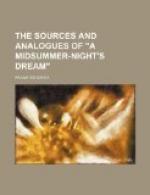Skeat says “some scraps are preserved in other poems” of Chaucer; he instances (i) ten stanzas from this Palamon and Arcite in a minor poem Anelida and Arcite, where Chaucer refers to Statius, Thebais, xii. 519;[11] (ii) three stanzas in Trolius and Crheyde; and (iii) six stanzas in The Parlement of Foules, where the description of the Temple of Love is borrowed almost word for word from Boccaccio’s Teseide.[12] Finally, Chaucer used Palamon and Arcite as the basis of The Knightes Tale. By this time, while he retains what folk-lorists call the “story-radical,” he has reduced Boccaccio’s epic to less than a quarter of its length, and improved it in details. It stands as the first of The Canterbury Tales.
ANALYSTS OF CHAUCER’S KNIGHTES TALE
Old stories relate that once there was a Duke Theseus, lord of Athens, a conqueror of many lands. His latest conquest was “Femenye” (once called Scythia), whose queen Hippolyta he wedded and brought home, accompanied by her young sister Emilia. Now as he drew near to Athens, a company of ladies met him in the way, and laid before him their complaint, to the effect that, their husbands having fallen at the siege of Thebes, Creon the tyrant of Thebes would not let the bodies be buried or burned, but cast them on a heap and suffered the dogs to eat them. Duke Theseus, having sworn to avenge this wrong, sent Hippolyta and Emilia to Athens, and rode to Thebes, where in full battle he fought and slew Creon, and razed the city. The due obsequies were then performed.[13]
Amongst the slain were found, half-dead, two young knights named Palamon and Arcite, whom the heralds recognised, from the cognisances on their armour, as of blood-royal, and born of two sisters. Theseus sent them to Athens to be held to ransom in prison perpetually, and himself returned home in triumph.
So years and days passed, and Palamon and Arcite dwelt in durance in a tower; till on a morrow of May it befel that the fair and fresh Emilia arose to do observance to May, and walked in the garden, gathering flowers and singing. Now in a high chamber of the tower, which adjoined the garden-wall, Palamon by leave of his gaoler was pacing to and fro and bewailing his lot, when he cast his eyes through the thick-barred window, and beheld Emilia in the garden below; whereat he blenched, and cried out as though struck to the heart. Arcite heard him, and, asking him why he so cried out, bade him suffer imprisonment in patience; but Palamon replied that the cause of his crying out was the beauty of the lady in the garden. Thereupon Arcite spied out of the window at Emilia, and was so struck by her fairness
“That if that Palamon was wounded
sore,
Arcite is hurt as muche as he, or more.”
So strife began between the two. Palamon said it were small honour for Arcite to be false to his cousin and sworn brother, since each had taken an oath not to hinder the other in love; nay, as a knight Arcite was bound to help him in his amour. But Arcite replied that love knows no law; decrees of man are every day broken for love; moreover Palamon and he were prisoners, and were like two dogs fighting for a bone which meantime a kite bears away. Let each continue in his love, for in prison each must endure.




